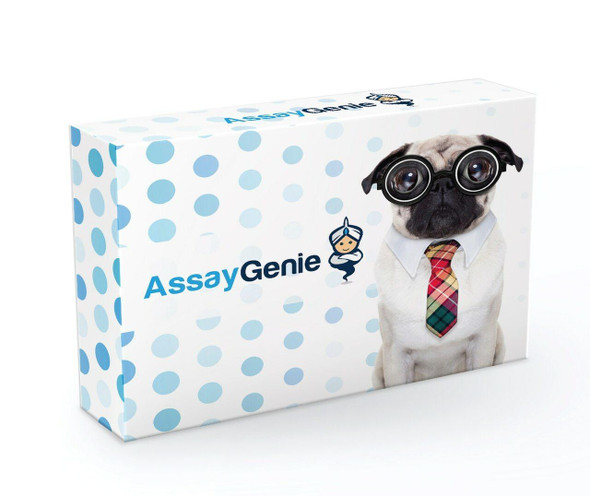Human Apo D Recombinant Protein (RPPB0050)
- SKU:
- RPPB0050
- Product Type:
- Recombinant Protein
- Species:
- Human
- Uniprot:
- P05090
- Research Area:
- Cytokines
Description
| Product Name: | Human Apo D Recombinant Protein |
| Product Code: | RPPB0050 |
| Size: | 10µg |
| Species: | Human |
| Target: | Apo D |
| Synonyms: | Apolipoprotein D, Apo-D, ApoD. |
| Source: | Escherichia Coli |
| Physical Appearance: | Filtered White lyophilized (freeze-dried) powder. |
| Formulation: | Filtered (0.4�m) and lyophilized from 1mg/ml in 4mM KH2PO4, 16mM Na2HPO4 and 115mM NaCl pH 7.5. |
| Solubility: | It is recommended to add deionized H2O to a working volume of 0.5mg/ml and let the lyophilized pellet dissolve completely. Product is not sterile! Please filter this product by an appropriate sterile filter before using it in the cell culture. |
| Stability: | Store lyophilized protein at -20°C. Aliquot the product after reconstitution to avoid repeated freezing/thawing cycles. Reconstituted protein can be stored at 4°C for a limited period of time; it does not show any change after two weeks at 4°C. |
| Purity: | Greater than 95% as determined by SDS-PAGE. |
| Amino Acid Sequence: | FHLGKCPNPP VQENFDVNKY PGRWYEIEKI PTTFENGRCI QANYSLMENG KIKVLNQELR ADGTVNQIEG EATPVNLTEP AKLEVKFSWF MPSAPYHILA TDYENYALVY SCTSISQSFH VDFAWILARN VALPPETVDS LKNILTSNNI DVKKMTVTDQ VNCPKLSAHHHHHH |
Apolipoprotein-D is mainly associated with high density lipoproteins in human plasma. Apolipoprotein-D is an atypical apolipoprotein and, based on its primary structure, Apolipoprotein-D is a member of the lipocalin family. Lipocalins adopt a beta-barrel tertiary structure and transport small hydrophobic ligands. Apolipoprotein-D binds cholesterol, progesterone, pregnenolone, bilirubin and arachidonic acid. Apolipoprotein-D is expressed in numerous tissues having high levels of expression in spleen, testes and brain. Apolipoprotein-D is present at high concentrations in the cyst fluid of women with gross cystic disease of the breast, a condition associated with increased risk of breast cancer. Apolipoprotein-D accumulates in regenerating peripheral nerves and in the cerebrospinal fluid of patients with neurodegenerative conditions, such as Alzheimer's disease. Apolipoprotein-D participates in maintenance and repair within the central and peripheral nervous systems. Apolipoprotein-D is a multi-ligand, multi-functional transporter and transports a ligand from 1 cell to another within an organ, scavenge a ligand within an organ for transport to the blood or could transport a ligand from the circulation to specific cells within a tissue.
Apolipoprotein-D Human Recombinant His Tag fusion protein at C-terminus (7 highlighted a.a.) produced in E.Coli is a single, non-glycosylated, Polypeptide chain containing 174 amino acids and having a molecular mass of 19.82kDa. The protein a.a sequence corresponds to the UniProtKB/Swiss-Prot entry P05090.The Following gene modifications were made:Trp99His, Cys116Ser, Ile118Ser, Leu120Ser amino acids exchanges were introduced at the surface of Apolipoprotein-D to enhance the protein�s solubility and another three Leu23Pro, Pro133Val, Asn134Ala amino acids exchanges which facilitate its genetic manipulation. The Apolipoprotein-D is purified by proprietary chromatographic techniques.
| UniProt Protein Function: | APOD: APOD occurs in the macromolecular complex with lecithin- cholesterol acyltransferase. It is probably involved in the transport and binding of bilin. Appears to be able to transport a variety of ligands in a number of different contexts. Belongs to the calycin superfamily. Lipocalin family. |
| UniProt Protein Details: | Protein type:Lipid-binding; Secreted, signal peptide; Secreted Chromosomal Location of Human Ortholog: 3q29 Cellular Component: cell soma; dendrite; endoplasmic reticulum; extracellular space; perinuclear region of cytoplasm Molecular Function:cholesterol binding; protein binding Biological Process: axon regeneration in the peripheral nervous system; brain development; glucose metabolic process; lipid metabolic process; negative regulation of focal adhesion formation; negative regulation of protein import into nucleus; negative regulation of smooth muscle cell proliferation; response to axon injury; response to drug; response to reactive oxygen species; tissue regeneration |
| NCBI Summary: | This gene encodes a component of high density lipoprotein that has no marked similarity to other apolipoprotein sequences. It has a high degree of homology to plasma retinol-binding protein and other members of the alpha 2 microglobulin protein superfamily of carrier proteins, also known as lipocalins. This glycoprotein is closely associated with the enzyme lecithin:cholesterol acyltransferase - an enzyme involved in lipoprotein metabolism. [provided by RefSeq, Aug 2008] |
| UniProt Code: | P05090 |
| NCBI GenInfo Identifier: | 114034 |
| NCBI Gene ID: | 347 |
| NCBI Accession: | P05090.1 |
| UniProt Secondary Accession: | P05090,Q6IBG6, B2R579, D3DNW6, |
| UniProt Related Accession: | P05090 |
| Molecular Weight: | 21,276 Da |
| NCBI Full Name: | Apolipoprotein D |
| NCBI Synonym Full Names: | apolipoprotein D |
| NCBI Official Symbol: | APOD�� |
| NCBI Protein Information: | apolipoprotein D |
| UniProt Protein Name: | Apolipoprotein D |
| Protein Family: | Apolipoprotein |
| UniProt Gene Name: | APOD�� |
| UniProt Entry Name: | APOD_HUMAN |









